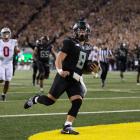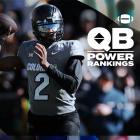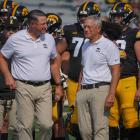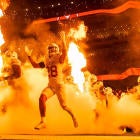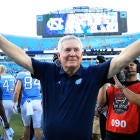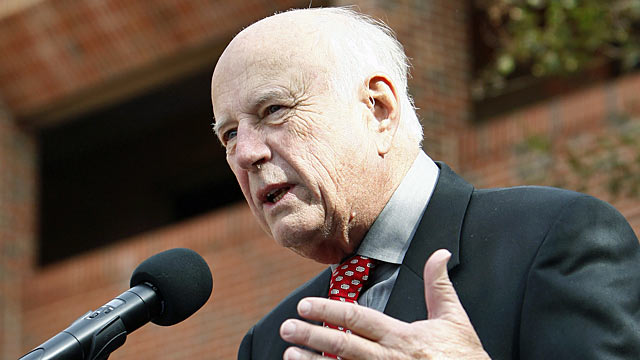
More: O'Bannon news | On CFB: Dennis Dodd | Jeremy Fowler | Jon Solomon
OAKLAND, Calif. -- Inside a small courtroom in Oakland over the past three weeks, amateurism in college sports has been on trial.
Lawyers representing college football and men’s basketball players paint a picture of the NCAA as a cartel that should share its television revenue. NCAA lawyers discuss the benefits associated with playing college sports and the damage that would come from letting athletes be paid.
More than anyone else, the late Supreme Court Justice Byron “Whizzer” White saw this day coming. White essentially predicted so much of this -- the commercialization, the defections for TV cash, the NCAA’s struggles to protect amateurism -- when he wrote the dissenting opinion in the landmark NCAA v. Oklahoma Board of Regents case that ended the NCAA’s monopoly over college football TV contracts.
“By mitigating what appears to be a clear failure of the free market to serve the ends and goals of higher education,” White wrote in 1984, “the NCAA ensures the continued availability of a unique and valuable product, the very existence of which might well be threatened by unbridled competition in the economic sphere.”
Friday marks the 30th anniversary of the Supreme Court decision, which can be directly traced to college football’s TV explosion.
Friday marks the last day of the Ed O’Bannon trial, where football and men’s basketball players want to end the NCAA’s rules prohibiting them from being paid off their names, images and likenesses.
That these two moments in time overlap is both symbolic and revealing of the state of college sports. Talk to prominent people associated with NCAA v. Board of Regents case and they express bewilderment at the amount of TV money their efforts eventually resulted in today.
“Athletics were supposed to be a byproduct of the academic environment,” said Andy Coats, the lawyer for the University of Oklahoma and the University of Georgia who argued before the Supreme Court in 1984. “What happened was it’s almost like the tail is wagging the dog. The football programs have become more important that I think everybody has concerns over how it’s going to end up. You could foresee some things happening, but I’m not sure anybody could see this coming.”
Former Texas athletic director DeLoss Dodds served on the College Football Association TV committee. He built Texas into the most lucrative college sports brand in America, a money-making machine that generated $165.7 million in 2012-13 revenue and has its own TV channel.
White has “absolutely been a prophet on what he said,” Dodds said. “The NCAA is losing some ground every day. Who knows where it ends with the O’Bannon case and all the other things going on?”
Chuck Neinas spent two years of his life fighting the NCAA on behalf of the CFA. He raised money for the Board of Regents lawsuit and put out fires after the rebellious CFA signed a TV deal in 1981 against the NCAA’s wishes. Neinas never imagined that as acting Big 12 commissioner in 2012 he would create a new bowl game with SEC commissioner Mike Slive commanding an $80 million annual rights fee from ESPN.
“When Mike and I were together and got that call from (ESPN president) John Skipper, ‘We don’t want to negotiate, we’ll give you the same deal as the Rose Bowl,’ we fell out of our chairs,” Neinas said. “Whoever expected a game that hadn’t been played would command the same rights fee as the Rose Bowl? It’s stunning to a degree.”
Freedom for schools and conferences to control their own TV rights forever changed college football. Universities switched conferences, salaries increased for coaches and administrators, conferences created their own branded TV networks, and the Bowl Championship Series and the College Football Playoff emerged.
June 27, 1984, allowed college football to eventually become America’s second-most popular sport behind the NFL.
June 27, 2014, will allow lawyers in Oakland to make their last oral arguments that players should be paid -- a debate that doesn’t have an expiration date.
“This is part of the legacy,” O’Bannon lawyer Bill Isaacson said. “Board of Regents absolutely led us to this point.”
TV money after Supreme Court
Lawyers dream of arguing before the Supreme Court. Coats lived the glamour life as the attorney for Georgia and Oklahoma in 1984.
Coats’ picture was on the front of sports pages across America holding up the Supreme Court opinion. He has lectured about the case around the country. The decision remains so significant in legal circles -- most major antitrust cases are usually brought by the Justice Department, not a private party -- that Coats talks about it at a law class at Oklahoma each year.
“I don’t think anybody really thought the Supreme Court would get involved,” Coats said. “We were very surprised when they did.”
The case was originally filed on Sept. 8, 1981. U.S. District Judge Lee Roy West recused himself immediately since he was an alum of Oklahoma, and the case moved to New Mexico under Judge Juan Guerrero Burciaga. An appellate court and the Supreme Court upheld Burciaga’s decision that the NCAA’s control over football TV contracts was illegal.
“Tough guy, ran a tight ship,” Coats said of Burciaga. “But he wrote the best trial court opinion I’ve ever seen. It helped us all the way to the Supreme Court. What he found was what John Paul Stevens relied on so much.”
Even then, new revenue was inherent in the push by schools to gain control over their broadcasts.
“Fred Davidson was president of Georgia and trying to pay for a stadium and felt there was more revenue he could get on television,” Coats said. “It was the live or die philosophy. They were telling the NCAA, ‘It’s our program. You don’t tell us what to do in other sports, only football.’”
To Neinas, the victory meant not only more football games on television, but better ones. Neinas remembers a handwritten note he once received from Alabama coach Bear Bryant in the 1970s imploring Neinas to do something because Michigan State-Notre Dame wouldn’t be aired in Alabama due to the NCAA showing a lower-level game.
“The NCAA plan was expanding the number of games, but still limiting the opportunities for those that were most attractive,” Neinas said. “I’ll never forget (former ABC Sports vice president) Jim Spence told (NCAA executive director) Walter Byers, ‘You’re simply watering down the scotch.’ They gave them more programming, but not more quality to sell.”
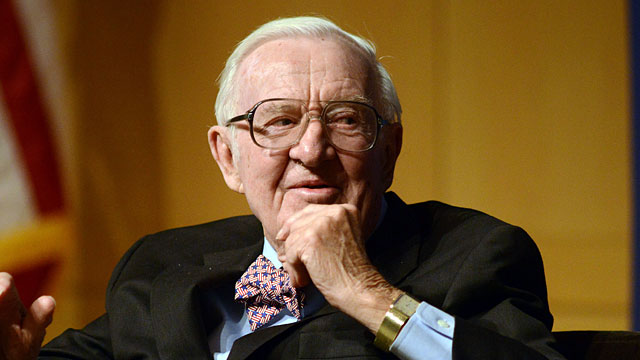
Since the Supreme Court ruling came in June, no one had the opportunity to develop leverage to negotiate TV contracts. Initially, the increased supply of potential games to broadcasters lowered the rights fees.
Under the NCAA’s proposed contract for 1984, colleges would have received $74 million. After the Supreme Court ruling, the revenues were closer to $31 million through the CFA, the consortium of 63 schools that formed to negotiate TV deals. A 30-second TV ad that commanded $60,000 during a college football game in 1983 sold for $15,000 in 1984.
The Supreme Court handed down a 7-2 decision against the NCAA. The only justice joining White in dissension was William Rehnquist. White warned the court was making a mistake by “subjugating the NCAA’s educational goals … to the purely competitive commercialism of [an] ’every school for itself’ approach to television contract bargaining.”
Today, some conference TV deals bring in billions of dollars. The new College Football Playoff is worth about $470 million annually. College sports is so flush with TV money that Conference USA -- which doesn’t exactly scream viewer interest for its football teams -- receives $84 million from Fox and CBS.
Coats said it was only a matter of time before the players sought a slice of the TV pie.
“They’re saying, ‘Look, we’re generating this money either by our play or the fact you take my image and sell it, and it’s not fair,’” Coats said. “Set aside some money for them until they graduate. I don’t see why the NCAA and the schools get all of that money, I really don’t. They should share in it.”
5 key words help NCAA
There’s another legacy of June 27, 1984. Buried within the NCAA’s landmark loss was a Supreme Court gift that keeps on giving: Limited language summed up by five words -- “athletes must not be paid.”
“Wouldn’t it be ironic if the Supreme Court decision is the one that saves the NCAA?” Neinas said, laughing at the thought.
Still to this day, the NCAA defends amateurism in part through these few lines in the court’s majority opinion from Stevens:
“… moreover, the NCAA seeks to market a particular brand of football -- college football. The identification of this ‘product’ with an academic tradition differentiates college football from and makes it more popular than professional sports to which it might otherwise be comparable, such as, for example, minor league baseball. In order to preserve the character and quality of the ‘product,’ athletes must not be paid, must be required to attend class, and the like …”
Never mind that NCAA v. Board of Regents wasn’t about compensating athletes. The NCAA has gained great legal traction through the years from those words.
“I think that statement is a clear indication that collegiate athletics with student-athletes not paid is worth preserving,” NCAA chief legal officer Donald Remy said. “But it’s not just that sentence or two. You have to look through the entirety of the majority opinion that talks about the uniqueness of the product and the value to the consumer. … Dozens of circuit courts have upheld that ruling through the years.”
Remy said the O’Bannon case doesn’t go directly to the issue set out in the Supreme Court since this trial focuses narrowly on group licenses for athletes’ names, images and likenesses.
“Some of the other (active NCAA) cases do go directly to this question,” Remy said. “I think the answer to this question should be the same because this collegiate model of athletics is something that’s valuable to our nation and can be preserved as a system of values.”
The O’Bannon trial judge, Claudia Wilken, previously shot down the significance of the 1984 Supreme Court decision as it relates to the NCAA’s restriction on paying players. The NCAA has continued to use amateurism as a defense in the O’Bannon trial, perhaps setting up for a likely appeal.
Last October Wilken wrote that while the Supreme Court ruling “gives the NCAA ‘ample latitude’ to adopt rules preserving ‘the revered tradition of amateurism in college sports’ ... it does not stand for the sweeping proposition that student-athletes must be barred, both during their college years and forever thereafter, from receiving any monetary compensation for the commercial use of their names, images and likenesses.”
The impact of 1984 at the Supreme Court has been felt at times in 2014 at the O’Bannon trial. Board of Regents v. NCAA provided an antitrust playbook for tackling and defending college sports’ rules.
The 1984 decision is why the O’Bannon trial has been conducted through a rule of reason analysis, said Isaascon, an attorney for the players. The rule of reason analysis is why testimony from the players’ economic expert, Roger Noll, took more than two full days of the 15 days of trial.
The O’Bannon lawyers got one of the TV architects from 1984, former CBS Sports president Neal Pilson, to testify that players have some undetermined value that wouldn’t hurt the TV product. Pilson’s testimony in some ways paralleled an NCAA argument in 1984.
The O’Bannon legal team dug deep to pull out an oral statement by the NCAA attorney who argued before the Supreme Court in 1984. NCAA attorney Frank Easterbrook, who is now a judge on the U.S. Court of Appeals for the 7th Circuit in Chicago, acknowledged to the nine justices in 1984 that college football’s market would increase if players were paid.
“We would get more viewers with semi-pro players,” Easterbrook said, according to Isaacson during this month’s trial. “The demand would be increased.”
Thirty years later, Neinas remains proud of what his efforts with the CFA produced. College football is wildly popular, although Neinas acknowledges that once unimaginable TV money now flowing into college sports has created problems. He questions how college football players could be paid from live TV broadcasts and rattles off rhetorical questions.
Does the quarterback get paid the same as the center? Don’t people realize college sports is voluntary? Does the public not understand that attorneys stand to make more money off these cases than the players? Doesn’t the 1984 Supreme Court decision still protect NCAA amateurism?








